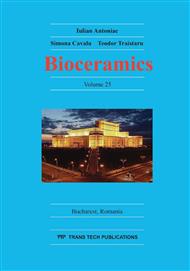p.171
p.179
p.185
p.191
p.197
p.205
p.211
p.215
p.222
Novel Three-Component Composite Materials (Hydroxyapatite/Polymer Mixtures) for Bone Regeneration
Abstract:
Biomaterial is a non-drug substance suitable for inclusion in systems which augment or replace the function of body tissues or organs. The nano-hydroxyapatite (HAp) is one of the most applied biomaterial, a popular bone substitute, for coatings and other filler materials due to their ability to promote mineralization. Hydroxyapatite [Ca10(PO4)6(OH)2] is one of the most stable forms of calcium phosphate and it occurs in bones as major component (60 to 65%), along with other materials including collagen, chondroitin sulfate, keratin sulfate and lipids. In order to improve the bioactivity and mechanical properties of hydroxyapatite, some synthetic and natural polymers (e.g., cellulose, collagen, chitosan, chitine) have been used as excellent candidates for bone/cartilage tissue engineering applications. In this paper we propose to synthesize novel three-component composite materials from HAp and cellulose (carboxymethyl cellulose, CMC) with one of the following natural polymers (chitosan (CS), chitine (CT), collagen (CLG), all of them named CX), biocompatible (from CMC) and with excellent antimicrobial activity (from HAp). Similarly to CS, CMC has an extensive network of intra- and inter-molecular hydrogen bonds which makes it insoluble in water or in common organic solvents. To prepare this new composite material, ionic liquids (ILs) have been used as potential green solvents for biopolymers, knowing that 1-butyl-3-methylimidazolium chloride [BMImCl] is able to dissolve up to 10% (w/w) of CMC, and other polysaccharides such as CS. In the studied systems, HAp particles were dispersed uniformly in organic phase, and are present strong chemical interactions between the three phases. In our case, a highly porous film was prepared and its bioactivity was investigated by in vitro tests in a simulated body fluid (SBF) for 6 months. By ICP-OES, was found a migration of analyzed metals (Fe, Mn, Cr and Ni) in simulated physiological fluids (SBF) analyzed after a period of 6 months, but only in the ppb concentrations range. Different system (HAp/CX/CMC) composites with weight ratios of 70/10/20, 70/15/15 and 70/20/10 were prepared. The new composites were characterized by infrared spectroscopy Fourier transformed (FT-IR), scanning electron microscopy (SEM) and ICP-OES. Their antimicrobial activity has been tested on Candida albicans, Candida parapsilosis and Staphylococcus aureus, proofing an excellent antimicrobial activity.
Info:
Periodical:
Pages:
197-204
Citation:
Online since:
November 2013
Price:
Сopyright:
© 2014 Trans Tech Publications Ltd. All Rights Reserved
Share:
Citation:


